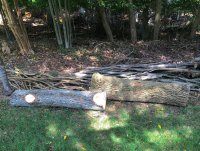barker7
New OPE Member
- Local time
- 8:20 AM
- User ID
- 19186
- Joined
- Sep 20, 2021
- Messages
- 4
- Reaction score
- 1
- Location
- Baltimore MD
I have two 6 foot sections from the trunk of an Ash tree that died from the emerald ash borer. I've built an acoustic guitar from thin delicate pieces of wood purchased on the internet, and now I want to build a solid body electric guitar from this tree. The finished overall dimensions of the guitar body vary by design, but its about 2" x 13" x 18". I'll probably make the body from 2 book matched slices.
I have a Stihl MS 180 with a 14" bar, that I have used for years to limb trees and cut up fire wood. I'm looking for ideas/strategies on how to cut up these logs.
My first thought was to cut them up into 2 ft lengths then somehow rip them, into 2" thick slabs. What I don't like about this idea is that if there is any internal rot or other defects, I won't have an opportunity to work around them.
My second idea is to rip them full length. I've seen some videos on this, but the saws are considerably larger than my saw and some use a chains ground for ripping.
1. Do you think my dinky saw could be used to rip these logs without killing the saw?
2. I couldn't find any rip chains that are 3/8" picco (which this saw uses). Is there a real benefit with a rip chain?
3. Any general tips or strategies? There's plenty of wood in those two logs, so I can screw up many times, but it would be great to have some guidance.
4. I included a picture of the end grain. Any thoughts on the grain or the little bit of spalting that should guide the cutting strategy?
Thanks everyone,
Mitch


I have a Stihl MS 180 with a 14" bar, that I have used for years to limb trees and cut up fire wood. I'm looking for ideas/strategies on how to cut up these logs.
My first thought was to cut them up into 2 ft lengths then somehow rip them, into 2" thick slabs. What I don't like about this idea is that if there is any internal rot or other defects, I won't have an opportunity to work around them.
My second idea is to rip them full length. I've seen some videos on this, but the saws are considerably larger than my saw and some use a chains ground for ripping.
1. Do you think my dinky saw could be used to rip these logs without killing the saw?
2. I couldn't find any rip chains that are 3/8" picco (which this saw uses). Is there a real benefit with a rip chain?
3. Any general tips or strategies? There's plenty of wood in those two logs, so I can screw up many times, but it would be great to have some guidance.
4. I included a picture of the end grain. Any thoughts on the grain or the little bit of spalting that should guide the cutting strategy?
Thanks everyone,
Mitch








